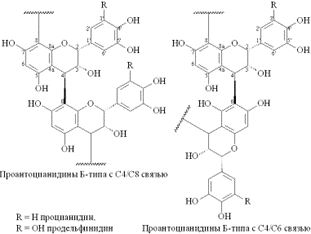ISOLATION AND STUDY OF PROANTHOCYANIDINS FROM BARK OF CEDAR PÍNUS SIBÍRICA
UDC 54.05:547.972
Abstract
The yields of proanthocyanidins isolated from the initial and deresinated (extracted with hexane) bark of the Siberian cedar (Pínus sibírica) by water, 15% water-ethanol solution and ethyl acetate in a Soxhlet apparatus were compared. It was shown, that the preliminary removal of resinous substances from the cedar bark does not affect the yields of proanthocyanidins extracted with water and 15% water-ethanol solution (for the initial bark is 0.44% (wt.) and 0.57% (wt.) and for the deresinated bark is 0.43% (wt.) and 0.57% (wt.), respectively). It was established that the extraction of deresinated bark with ethyl acetate makes it possible to increase the yield of proanthocyanidins about 2 times to 1.04% (wt.). The composition of the proanthocyanidins isolated from the cedar bark was characterized by UV, FTIR, and 13C NMR spectroscopy methods. The flavonoids cyanidin and delphinidin were identified using the conversion proanthocyanidins to anthocyanidins. The proanthocyanidins isolated from cedar bark mainly consist of procyanidin and prodelphinidin, regardless of the method of their isolation – extraction by water, 15% aqueous ethanol solution or ethyl acetate. It was established that the proanthocyanidins isolated from the bark of cedar, in contrast to those isolated from the bark of pine (Pinus maritima) and (Pinus radiata), contain gallic acid residues.
Downloads
Metrics
References
Kuz'micheva N.A., Buzuk G.N., Kurlyuk O.V. Vestnik farmatsii, 2016, vol. 71, no. 1, pp. 72–75. (in Russ.).
Osipov V.I., Polyakov N.A., Sidel'nikov A.N., Khaziyeva F.M. Rastitel'nyye resursy, 2017, vol. 53, no. 1, pp. 114–125. (in Russ.).
Diouf P.N., Tibirna C.M., García-Pérez M.-E., Royer M., Dubé P., Stevanovic T. JBNB, 2013, vol. 4, no. 3A, pp. 1–8. DOI: 10.4236/jbnb.2013.43A001.
Haslam E. J. Nat. Prod., 1996, vol. 59, no. 2, pp. 205–215. DOI: 10.1021/np960040+.
Sprygin V.G., Kushnerova N.F. Pharm. Chem. J., 2002, vol. 36, no. 3, pp. 139–143. DOI: 10.1023/A:1019682311646.
Ku C.S., Mun S.P. Wood Sci. Technol., 2007, vol. 41, no. 3, pp. 235–247. DOI: 10.1007/s00226-006-0103-8.
Yazaki Y. Nat. Prod. Commun., 2015, vol. 10, no. 3, pp. 513–520. DOI: 10.1177/1934578X1501000333.
Chang Q., Zhu M., Zuo Z., Chow M., Ho W.K.K. J. Chromatogr. B: Biomed. Sci. Appl., 2001, vol. 760, no. 2, pp. 227–235. DOI: 10.1016/S0378-4347(01)00273-0.
Kim S.H., Kang K.W., Kim K.W., Kim N.D. Life Sciences, 2000, vol. 67, no. 2, pp. 121–131. DOI: 10.1016/s0024-3205(00)00608-1.
Bors W., Michel C., Stettmaier K. Arch. Biochem. Biophys., 2000, vol. 374, no. 2, pp. 347–355. DOI: 10.1006/abbi.1999.1606.
Deyneko I.P. Faustova N.M. Khimiya rastitel'nogo syr'ya, 2015, no. 1, pp. 51–62. DOI: 10.14258/jcprm.201501461. (in Russ.).
Levdanskiy V.A., Korol’kova I.V., Levdanskiy A.V., Kuznetsov B.N. Russ. J. Bioorg. Chem., 2021, vol. 47, no. 7, pp. 1445–1450. DOI: 10.1134/S1068162021070098.
Fu C., Yang D., Peh W.Y.E., Lai S., Feng X., Yang H. J. Food Sci., 2015, vol. 80, no. 10, pp. C2191–C2199. DOI: 10.1111/1750-3841.13005.
Takahashi T., Nagatoishi S., Kuroda D., Tsumoto K. PLoS One, 2018, vol. 13, no. 10, 0204856. DOI: 10.1371/journal.pone.0204856.
Levdanskiy V.A., Kondrasenko A.A., Levdanskiy A.V., Lutoshkin M.A. Zhurnal SFU. Khimiya, 2019, vol. 12, no. 4, pp. 604–613. DOI: 10.17516/1998-2836-0155. (in Russ.).
Plumb G.W., De Pascual-Teresa S., Santos-Buelga C., Cheynier V., Williamson G. Free Radical Research, 1998, vol. 29, no. 4, pp. 351–358. DOI: 10.1080/10715769800300391.
Levdanskiy V.A., Polezhayeva N.I., Makiyevskaya A.I., Kuznetsov B.N. Khimiya v interesakh ustoychivogo razvitiya, 2000, vol. 8, no. 6, pp. 823–827. (in Russ.).

Copyright (c) 2022 chemistry of plant raw material

This work is licensed under a Creative Commons Attribution 4.0 International License.

This work is licensed under a Creative Commons Attribution 4.0 International License.
The authors, which are published in this journal, agree to the following conditions:
1. Authors retain the copyright to the work and transfer to the journal the right of the first publication along with the work, at the same time licensing it under the terms of the Creative Commons Attribution License, which allows others to distribute this work with the obligatory indication of the authorship of this work and a link to the original publication in this journal .
2. The authors retain the right to enter into separate, additional contractual agreements for the non-exclusive distribution of the version of the work published by this journal (for example, to place it in the university depository or to publish it in a book), with reference to the original publication in this journal.
3. Authors are allowed to post their work on the Internet (for example, in a university repository or on their personal website) before and during the review process of this journal, as this may lead to a productive discussion, as well as more links to this published work.











